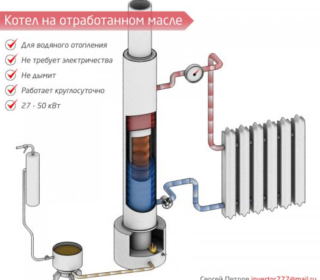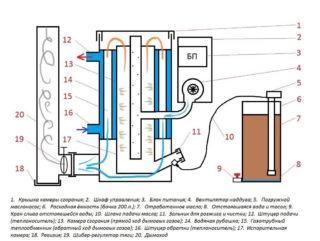A waste oil boiler with a water circuit is a floor heating equipment that operates on unusual fuels in the form of waste. The device is economical, superior to gas analogues. The design will be the best choice for providing heat to private houses, where it is expensive to use electricity for heating, and a gas pipeline is not provided or is still under development. The boiler will solve the problem of heating large areas from 600 meters, save money for people who have free access to large volumes of used oil.
Operating principle
Waste oil boilers with a water circuit have some differences with diesel / gas designs. Before burning, the fuel must be strongly heated in a specialized chamber, which is most often located on the outside of the burner.
Principle of operation:
- Through the pump from the fuel storage tank, the waste is transported to the preheating tank. A special float controls the volume delivered.
- Using a heating element (TEN), the oil is adjusted to 80-110 ° C.
- After reaching the operating temperature, fuel is transported through the nozzle to the combustion chamber, where it is mixed with air by turbo-charging.
- The heat exchanger is heated and transfers energy to the coolant circulating in the circuit.
Vertical drip models operate on a slightly different principle:
- from an external reservoir, oil is poured onto a hot bowl located in the combustion chamber;
- Once on a hot surface, the fuel evaporates;
- due to air injection, the resulting mixture completely burns out.
The walls of the chamber in this case are a water jacket, which, when heated, shares heat with the coolant.
The air-oil mixture burns at a temperature determined by the manufacturer. Most often, the parameters vary within 600 ° C. It is important to ensure that there are no deviations from the norm, otherwise it will lead to rapid contamination of the combustion chamber and other parts of the equipment, the process of fuel burning will be incomplete and toxic substances will begin to form inside the boiler. To increase safety and increase the service life of the structure, commissioning is advisable to trust professional craftsmen with the appropriate qualifications.
To generate 11 kW of heat, 1 liter is needed. working out. With natural losses on average at a power of 30 kW, 3 liters of fuel per hour will be consumed. The parameters specified in the manufacturer's instructions are mainly designed for continuous operation of the equipment.
Advantages and disadvantages
 The main advantages of the oil boiler include:
The main advantages of the oil boiler include:
- Autonomy. The oil-based heating system does not require gas supply.
- Reliability. A simple, understandable design with proper and accurate operation rarely requires repair. The main thing is to timely carry out maintenance and change worn parts.
- Benefit, savings. Waste oil is an inexpensive and efficient type of fuel and is cheaper than gas and electricity.
- A wide range of applications: office buildings, residential buildings, industrial / industrial areas, etc.
- Environmental friendliness. During operation, the fuel burns out completely, which guarantees the absence of emissions of harmful substances into the atmosphere.
- Fast heating. Operating temperature is reached quickly, heat transfer starts from the first minutes of operation.
In addition to the advantages, the development boiler has minor disadvantages:
- The need for regular maintenance. Since the used oil is recyclable, it contains a variety of impurities that settle on the surfaces of the structure. To reduce frequent breakdowns, the walls of the combustion chamber require constant cleaning of contaminants.
- Installation of the chimney. Oil-fired boilers require the installation of additional elements.
Before choosing equipment of this type, it is necessary to assess the availability of fuel. The development is mainly implemented at service stations and some enterprises.
Double-circuit boilers
Double-circuit oil heating allows, in addition to heat, to provide residential / non-residential premises with hot water supply. The flat surface of the tank filled with water warms up and the pressure in the line is regulated with the help of a pump. The temperature of the supplied liquid practically does not change, therefore, dilution with cold water is necessary.
It is recommended to use tanks with a volume of not more than 140 liters in heating working on working out. The boiler heats up in a short period of time, an average of 2 hours, depending on the size of the reservoir.
DIY oil boiler
For a do-it-yourself boiler, you will need:
- sheet material for a tank, a cover;
- oil pump;
- heat-resistant sealant;
- pipe for chimney equipment;
- steel adapters;
- fan;
- supporting metal adapters.
It is also important to pre-prepare the tools: a welding machine with electrodes, a grinder, a construction tape measure, a set of keys, a drill, a hammer. As a boiler, you can use barrels for oxygen / propane, this will speed up and facilitate the procedure.
Stages of independent production of equipment:
- drawing up a drawing - most often the optimal finished option is taken and adapted to certain conditions;
- selection of materials - brand, thickness of steel are taken into account;
- creating a device according to the scheme.
During welding, it is important to ensure that the seams are tight and reliable. To adjust the position, legs are welded to the bottom, which, if necessary, change the height. After the preparation of the boiler, control tests are conducted, where the power is gradually increased.
For uniform distribution, fuel inflow, automation is used, which is implemented in specialized retail outlets.
Installation of boiler and chimney
 The oil heating boiler is located in a pre-selected place at a certain distance from flammable elements. If desired, you can organize a concrete platform with a protective side, which will ensure safety during fuel overflow. The automation unit is preferably mounted on the wall. Equipment should be easily accessible.
The oil heating boiler is located in a pre-selected place at a certain distance from flammable elements. If desired, you can organize a concrete platform with a protective side, which will ensure safety during fuel overflow. The automation unit is preferably mounted on the wall. Equipment should be easily accessible.
Wires, oil hoses are insulated so that there is no direct contact with the hot boiler. Thermal sensors are mounted on the side of the tube, and the mining tank is placed within 1.5 meters of the heated surface of the structure.
When installing the chimney, the following rules are observed:
- the diameter corresponds to the outlet of the pipe;
- the thickness of the metal pipe is not less than 0.5 mm;
- no more than three turns;
- height not less than 5 meters.
The chimney should rise above the roof.
Operational Features
During operation, in order to extend the life of the equipment, it is necessary to regularly carry out the following measures:
- cleaning the combustion chamber;
- cleaning the oil supply pipe;
- blowing automation from dust.
You must also follow all the manufacturer's recommendations.
A self-made boiler for development should be safe. The device must be placed at a distance from combustible objects, materials. Since during the operation of the boiler there is an increased burnout of oxygen, it is important to provide the room with ventilation and a chimney with draft regulation.At the intersection of the chimney with the roof put a protective casing.





